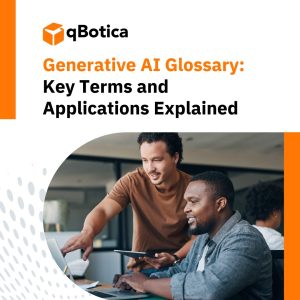The Fourth Industrial Revolution (4IR) is reshaping our world through the fusion of advanced technologies that merge physical, digital, and biological domains. Coined by Klaus Schwab of the World Economic Forum, this revolution promises transformative changes, similar to the first and second industrial revolutions. Key innovations include artificial intelligence, robotics, and the Internet of Things (IoT).
While 4IR offers potential for global income growth and enhanced quality of life, it is crucial to critically assess its implications. For instance, the integration of Robotic Process Automation (RPA) in manufacturing could revolutionize operations by increasing efficiency and productivity. Companies like qBotica are already scaling up their ecosystem approach to help enterprises adapt to these changes.
Navigating the challenges posed by these rapid advancements requires careful consideration. The impact of 4IR is not limited to manufacturing; it extends to various sectors including healthcare and real estate. In the healthcare sector, RPA can serve as a strategic resource to help health systems regain their footing post-pandemic, as detailed in qBotica’s report on Nursing Healthcare. Similarly, in real estate, intelligent document processing powered by RPA can streamline complex tasks, as seen in qBotica’s Real Estate and Mortgage Use Cases.
Understanding the Fourth Industrial Revolution
The Fourth Industrial Revolution (4IR) is powered by a range of cutting-edge technologies. Key drivers include:
- Artificial Intelligence (AI): AI enables machines to perform tasks that typically require human intelligence, such as learning, problem-solving, and decision-making.
- Robotics: Robotics leverages AI to automate complex tasks in manufacturing, healthcare, and even customer service. For instance, qBotica, a leading robotic process automation company, is revolutionizing industries by automating repetitive tasks.
- Quantum Computing: Quantum computing promises unprecedented processing power, enabling solutions to problems previously deemed unsolvable.
- Bioengineering: Advancements in bioengineering lead to medical breakthroughs, from gene editing to regenerative medicine. The medical revolution has been characterized by innovations like precision medicine and telehealth services.
- Internet of Things (IoT): IoT connects everyday objects to the internet, allowing for real-time data collection and communication.
These technologies are not isolated; they interconnect and contribute to the fusion of physical, digital, and biological worlds.
For instance:
- ChatGPT, an AI language model developed by OpenAI, showcases how AI can assist in generating human-like text based on prompts.
- Robotic Process Automation (RPA) exemplifies how robotics can automate repetitive tasks across various industries.
The convergence of AI, robotics, quantum computing, bioengineering, and IoT continues to redefine our interaction with technology across all facets of life. This is particularly evident in sectors such as finance and accounting where intelligent automation is streamlining tasks and enhancing decision-making processes. Similarly, in healthcare, advanced denial management strategies spearheaded by qBotica’s automation solutions are revolutionizing healthcare billing processes and ensuring maximum revenue retention.
Moreover, companies are leveraging platforms like UiPath for effective onboarding processes. For more information on how UiPath simplifies these processes while driving significant efficiencies through automation tools like RPA within various industries including healthcare and real estate mentioned above visit qBotica’s detailed guide on UiPath onboarding.
The Discrepancy Between Expectations and Reality in 4IR
Global income growth and an improved quality of life for individuals are among the significant benefits anticipated from the Fourth Industrial Revolution. The convergence of groundbreaking technologies promises economic upliftment and societal advancements. For instance:
- Artificial Intelligence (AI) could revolutionize healthcare by providing precise diagnostics and streamlining processes such as claims processing.
- Robotics can enhance manufacturing efficiency, reducing costs and increasing productivity. This is evident in case studies where companies have achieved faster month-end closures with a 99% reduction in errors through intelligent automation.
- Quantum computing offers unprecedented computational power that can solve complex problems.
But it’s not like we expected. While these potentials are exciting, the reality sometimes falls short.
Key Points of Discrepancy
- Economic Inequality: Despite the promise of global income growth, there is evidence suggesting increased inequality. Advanced technologies may benefit those with access to education and resources, leaving others behind.
- Job Displacement: While AI and automation create new job opportunities, they also displace traditional roles. This shift requires workers to rapidly adapt, which isn’t always feasible.
- Access to Technology: Not all regions have equal access to cutting-edge innovations. This digital divide can exacerbate existing disparities.
These discrepancies highlight the importance of critically assessing 4IR’s implications to ensure its benefits are broadly shared. For example, while intelligent automation can significantly improve efficiency and reduce errors in various sectors such as manufacturing by ensuring product quality and compliance, it’s crucial that such advancements are accessible to all rather than a privileged few.
Challenges Posed by Technological Advancements in 4IR
Labor Market Disruptions
Technological advancements bring both opportunities and challenges to labor markets:
- Job Displacement: Automation may replace some traditional jobs while creating new roles that require different skills.
- Skill Gaps: Workers need continuous training to keep up with technological changes.
- Income Inequality: Those who adapt quickly benefit while others might be left behind.
These disruptions necessitate strategic responses from organizations:
Opportunities for Intelligent Automation
Intelligent automation provides numerous opportunities for businesses:
- Efficiency Gains: Automated processes save time and reduce errors.
- Cost Reduction: Automation lowers operational costs.
- Enhanced Productivity: Employees focus on higher-value tasks.
For instance:
Adapting to Change: Employment Dynamics in 4IR
Employment dynamics evolve with technological progress:
- Continuous Learning: Employees must continually update their skills.
- Flexibility: Adaptability becomes crucial for career longevity.
- Collaboration: Organizations should foster environments conducive to teamwork between humans & machines.
Preparing Workers for New Demands: The Role of Organizations in Workforce Development
Organizations play an essential role in preparing workers for future demands:
- Training Programs: Offering regular skill development sessions helps employees stay relevant.
- Mentorship: Experienced staff guide newcomers through transitions into new roles or technologies. 3Career Path Planning: Organizations can assist employees in identifying career paths aligned with emerging technologies.
- Reskilling and Upskilling Initiatives: Investing in reskilling programs helps employees adapt to changing job requirements.
- Promoting a Learning Culture: Encouraging a culture of continuous learning fosters employee engagement and promotes innovation.
- Collaboration with Educational Institutions: Partnering with universities and training institutes can help bridge the skills gap.
Embracing Diversity and Inclusion: Emphasizing diverse perspectives fosters creativity and innovation in the face of technological change.
Collaboration Strategies:
- Industry Partnerships: Collaborating with other organizations within the industry to share knowledge and resources.
- Public-Private Partnerships: Engaging with government entities to develop policies and programs that support workforce development.
- Cross-sector Collaboration: Partnering with different sectors to integrate diverse technologies and methodologies.
- Global Alliances: Forming international partnerships to leverage global expertise and innovation.
Case Studies:
- Siemens’ Dual Education System:
- Siemens has implemented a dual education system in Germany, combining apprenticeships with vocational education.
- This model helps bridge the skills gap by providing hands-on experience alongside academic learning.
- Amazon’s Upskilling 2025 Initiative:
- Amazon committed to investing $700 million to upskill 100,000 employees by 2025.
- The initiative focuses on training employees for roles in software engineering, IT support, and other tech-driven fields.
Understanding Future Trends in Customer Expectations During 4IR
As we advance deeper into the Fourth Industrial Revolution, customer expectations are evolving rapidly. Consumers now demand more personalized experiences, seamless interactions across multiple platforms, and faster service delivery.
The Role of Data Collection in Understanding Consumer Needs
Data collection plays a crucial role in understanding consumer behavior and preferences. By analyzing data from various sources, businesses can gain insights into customer needs and tailor their offerings accordingly.
Adapting to New Dynamics: The Importance of Personalization and Automation
Personalization and automation are key to meeting new customer expectations:
- Personalization: Leveraging data to offer customized products and services enhances customer satisfaction.
- Automation: Implementing automated systems can streamline operations, reduce costs, and improve service efficiency.
Managing Data in Industries like Aerospace
In industries such as aerospace, managing vast amounts of data is critical:
- Utilizing advanced analytics to predict maintenance needs and improve safety.
- Implementing IoT devices for real-time data collection and monitoring.
Lessons from History: Technological Continuities Across Industrial Revolutions
Examining past industrial revolutions reveals patterns of technological adoption, resistance to change, and eventual societal transformation. These lessons can guide current strategies for navigating 4IR challenges.
Conclusion: Embracing Opportunities and Addressing Challenges in 4IR
The Fourth Industrial Revolution offers unprecedented opportunities for innovation, efficiency, and growth. However, it also presents significant challenges that require proactive strategies. By embracing change, fostering collaboration, and investing in workforce development, we can harness the full potential of 4IR while mitigating its risks.
FAQs (Frequently Asked Questions)
The Fourth Industrial Revolution refers to the ongoing transformation driven by advanced technologies that blend physical, digital, and biological spheres.
Key challenges include labor market disruptions, ethical concerns related to AI and automation, cybersecurity threats, and the need for continuous skill development.
4IR impacts employment dynamics by creating new job roles while rendering some traditional jobs obsolete. It necessitates reskilling and upskilling of the workforce.
Organizations are crucial in providing training programs, mentorship opportunities, career path planning, reskilling initiatives, promoting a learning culture, collaborating with educational institutions, and embracing diversity.
Customers now expect personalized experiences, seamless multi-platform interactions, faster service delivery, and greater responsiveness from businesses.
Data collection helps businesses analyze consumer behavior patterns and preferences, allowing them to tailor their products and services more effectively.




